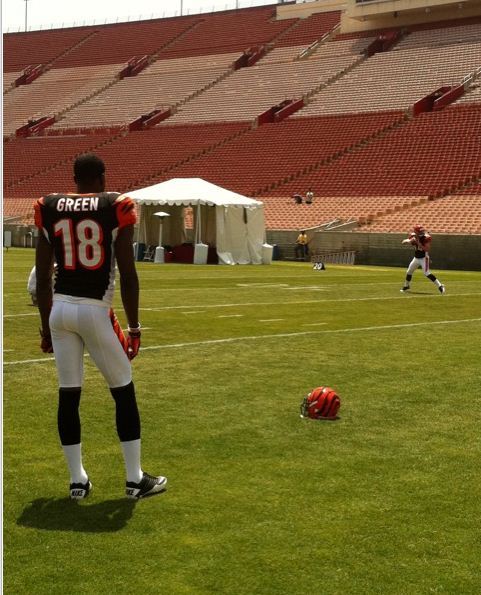I used to think that good scheme and
inventive playcalling could overcome a lack of talent. I remember
banging the drum in 2009, saying the Bengals could win without Chris
Henry—that the other guys would step it up. That didn't happen.
True, it wasn't the most impressive coaching displays late that
season by the offensive coordinator, but ultimately, it came down to
simply not having the guns to move forward in the playoffs.
Last week against Pittsburgh, after AJ
Green left the field, it felt that same way. Caldwell, Baby Hawk,
and Jerome Simpson did not strike any kind of fear in the hearts of
the Steeler defense. The timing went away, the routes became more
round, and miscommunication set in like the ghost of Carson Palmer.
It's amazing to think that by removing just one receiver from the
game plan, the whole equation of success breaks down. Yet that is
what happened in 2009 when Henry broke his arm and later died, and
again in a much smaller dose last week in the second half when Green
tweaked his knee.
The good news is that Green is going to
be okay. Nothing tore in that precious knee of his and although the
team will treat him delicately, his return is imminent if not for
this week then for next. However, it seems logical on the part of
the Bengals coaching staff to prepare the secondary-role players for
more of a spotlight part should the team be in the same precarious
situation again. Can anyone within their current receiving corps
step up and at least act like a number one wideout, or must the group
as a whole equally elevate their game to allow for further success?
And even with Green on the field, can the others get better
throughout the second half of the season?
Jay Gruden will have a heavy say in
answering these questions. He must continue to change the shape of
the offensive scheme week in and week out in order for the Bengals
offense to remain fresh and unpredictable. I sensed more
predictability in the playcalling last week than at any other point
so far this year, but I also expected this as Dalton had yet to cut
his teeth on the Steeler defense. I just knew that Marvin would want
safe plays with lots of running and power formations and try to win
with the kicking game—to protect Andy Dalton as much as he could.
But once Green left the game, the talent level plummeted and training
wheels were attached to the offensive scheme. It went beyond safe;
it became mostly harmless.
The defense is a different animal
altogether. It too lost a figurehead on their side of the ball in
Leon Hall, but still kept it together enough to give the team
multiple chances to tie things up late in the game. Steeler wide
out Antonio Brown appeared impossible to guard in the short term—and
I was worried—but the remaining corners got their act together and
made winning possible in the end.
There were a lot of good things that
came out of this game for the Bengals. The offensive line pass
protected very well, Dalton displayed his tremendous pocket presence
and many times threw the ball out of bounds rather than take a sack
or force a pass into coverage. The defense put good pressure on Big
Ben and kept the Steelers ground game to a minimal. Penalties were
low and there was really just one bad turnover in the game (the
deflected pass for the first interception gets chalked up to the
“stuff happens” category). The national perception of this game
is that it was an impressive loss for the Stripes and that they
proved they could at least compete with the other divisional big
dogs, and they did so after losing a couple of key pieces in the
process. Nonetheless, the passing game looked weak without Green
and future opponents are likely to take note of that and gameplan
accordingly. If I were a defense, I would rather Jerome Simpson beat
me then the high-caliber rookie.
The running game has proven to still be
necessary in this pass-happy world, but throwing effectively will
always be the quickest way out of trouble. Dalton and crew were
modestly effective in the first half of the season but the unit will
have to improve, not just remain average. I feel we all know what
Caldwell brings to the table—he's consistently alright—but
Simpson continues to be a frustrating wild card. He looks like a
receiver, he runs well, but he drops way too many passes and he just
can't put it altogether. I would rather have a less talented but
more reliable player than an all-or-nothing guy catching the ball.
Hawkins is a nice, jukey little player but doesn't seem to have the
tools of an every-down number-two receiver. Gresham, of course, is
the next best pass-catcher behind Green, but his role on this team
isn't of the ariel-threat variety. Yes, he is an intriguing red-zone
target, and is a tough runner with the ball in his hands, but he
isn't much of a focal point to this offense the way Jason Witten is
to his scheme, for example. Gresham has blocked a lot and hasn't
been able to stretch the field much, yet both Donald Lee and Colin
Cochart have had explosive plays the last few weeks—it's odd.
I'm not advocating panic in regards to
the passing game; I'm only pointing out how the talent that does
exist there, needs to get significantly better for the Bengals to win
against the best teams. I think this is a well-coached team who will
make the necessary developments to succeed and very possibly make the
playoffs. Marvin spoke this week about the need to stay creative
offensively and to not become predictable, so we at least know he is
aware of the concern as well. The next few weeks are against
familiar foes who seem much more beatable than perhaps many others
would suggest. The Ravens and Steerlers II are games the Bengals
should win if they're a team on the rise but they cannot settle for
average performances if that is to happen; they have to learn to
elevate their games in the face of difficulty and uncertainty no
matter who is playing and who is injured.
Rise to the top. Surpass the
limitations.
Mojokong—where is my coat?





